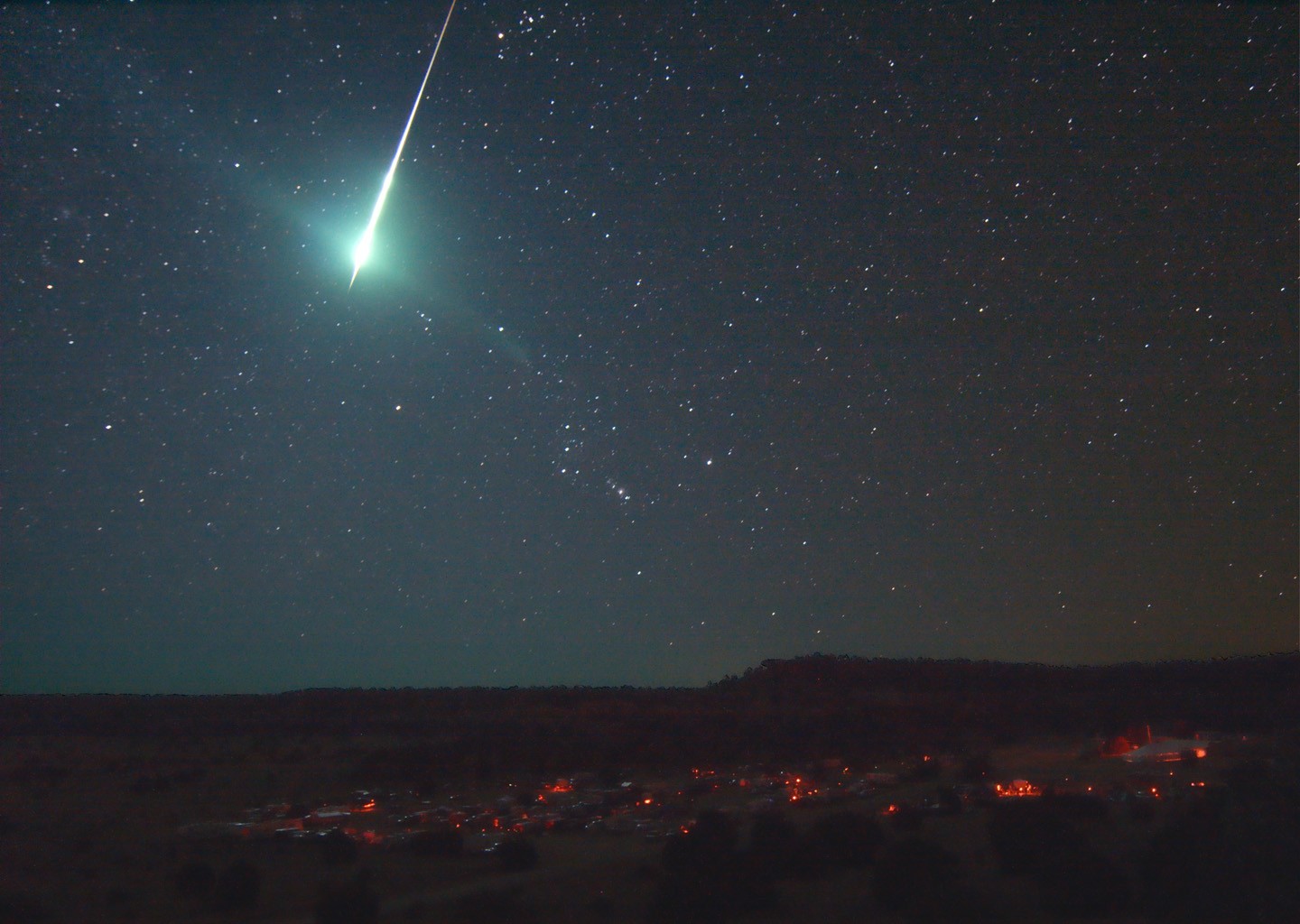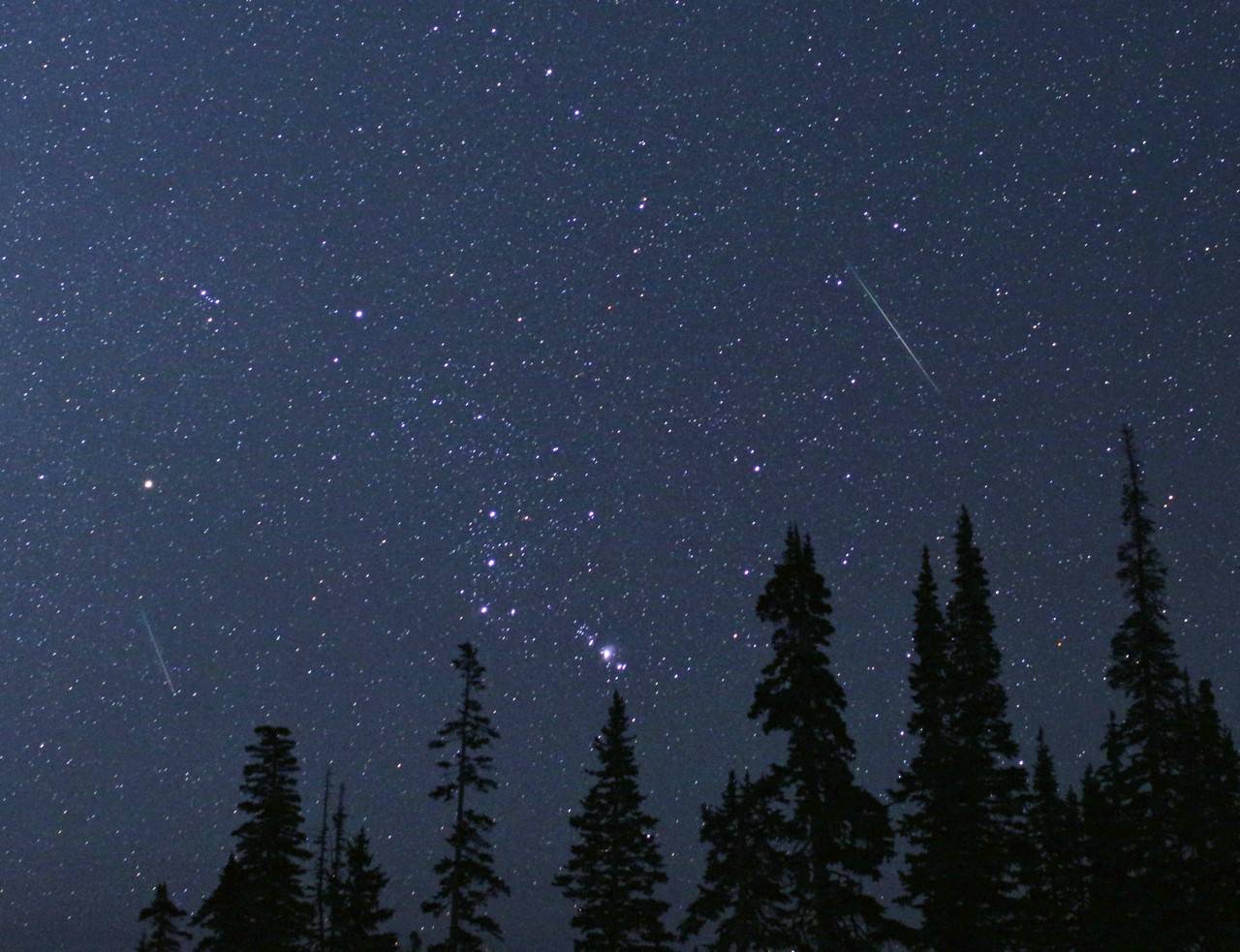A meteor is the visible streak of light from a space rock burning up as it enters Earth’s atmosphere. At WHAT.EDU.VN, we’re here to illuminate the wonders of space for you. This guide will cover everything from the science behind meteors to meteor showers and the difference between meteors, meteoroids, and meteorites, ensuring you have a clear understanding of these fascinating celestial events, enhancing your astronomical knowledge and sparking your curiosity about the cosmos. Explore the difference between space debris, space rocks, and bolides.
1. What Is The Definition Of A Meteor?
A meteor is the flash of light that we see in the sky when a small piece of space debris, called a meteoroid, enters Earth’s atmosphere and burns up due to friction. This creates a “shooting star” effect. According to NASA, meteors are meteoroids that have entered Earth’s atmosphere.
1.1. What Is The Origin Of The Word “Meteor?”
The word “meteor” comes from the Greek word meteōros, meaning “high in the air.” This accurately describes the phenomenon of a meteor streaking across the sky.
1.2. What Happens When A Meteoroid Enters Earth’s Atmosphere?
As a meteoroid hurtles through the atmosphere, it encounters resistance from air molecules. This resistance generates immense heat, causing the meteoroid to vaporize. The glowing, hot air surrounding the burning meteoroid is what we observe as a meteor.
2. What Are The Key Characteristics Of A Meteor?
Meteors are characterized by their brief but brilliant streaks of light. They can vary in brightness, color, and speed, depending on the size, composition, and velocity of the original meteoroid.
2.1. What Determines The Brightness Of A Meteor?
The brightness of a meteor is primarily determined by the size and speed of the meteoroid. Larger and faster meteoroids create brighter meteors. Very bright meteors are often called fireballs or bolides.
2.2. What Are Fireballs And Bolides?
Fireballs are meteors that are brighter than normal. There is no strict definition, but typically, a fireball is as bright or brighter than the planet Venus. Bolides are a type of fireball that explodes in the atmosphere. NASA’s All Sky Fireball Network tracks these events.
2.3. How Fast Do Meteors Travel?
Meteors travel at extremely high speeds, ranging from about 11 to 72 kilometers per second (25,000 to 160,000 miles per hour). The faster the meteoroid, the more dramatic the meteor.
3. What Is The Difference Between A Meteor, A Meteoroid, And A Meteorite?
It’s easy to confuse these terms. Here’s a breakdown:
- Meteoroid: A small rock or particle in space, ranging in size from dust grains to small asteroids.
- Meteor: The streak of light produced when a meteoroid enters Earth’s atmosphere and burns up.
- Meteorite: A meteoroid that survives its passage through the atmosphere and lands on Earth’s surface.
3.1. How Common Are Meteorites?
While many meteoroids enter the atmosphere each day, most burn up completely. Only a small fraction survive to become meteorites. Scientists estimate that about 48.5 tons (44 tonnes or 44,000 kilograms) of meteoritic material falls on Earth each day, according to NASA.
3.2. Where Are Meteorites Usually Found?
Meteorites can be found anywhere on Earth, but they are often easier to spot in deserts or icy regions like Antarctica, where they stand out against the landscape. Organizations like ANSMET (Antarctic Search for Meteorites program) conduct expeditions to find meteorites in Antarctica.
4. What Are Meteor Showers And How Are They Formed?
A meteor shower is an event where numerous meteors are observed to radiate from one point in the night sky. These showers occur when the Earth passes through the debris field of a comet.
4.1. What Causes Meteor Showers?
Comets are icy bodies that shed dust and debris as they orbit the Sun. When Earth passes through these debris trails, the particles enter our atmosphere, creating meteor showers.
4.2. How Are Meteor Showers Named?
Meteor showers are typically named after the constellation or star near the radiant, the point in the sky from which the meteors appear to originate. For example, the Perseids appear to come from the constellation Perseus.
4.3. What Are Some Of The Most Famous Meteor Showers?
Some of the most well-known meteor showers include:
- Perseids: Peak in August. Every Perseid meteor is a tiny piece of the comet Swift-Tuttle, which swings by the Sun every 135 years, according to NASA.
- Geminids: Peak in December.
- Leonids: Peak in November.
- Orionids: Peak in October.
4.4. How Can I Best Observe A Meteor Shower?
To best observe a meteor shower, find a dark location away from city lights. Give your eyes about 20-30 minutes to adjust to the darkness. Lie on your back and look up at the sky. No special equipment is needed. NASA provides skywatching tips for observing the night skies.
5. What Are The Different Types Of Meteorites?
Meteorites are classified into three main types based on their composition:
- Stony meteorites: Primarily composed of silicate minerals.
- Iron meteorites: Mostly made of iron and nickel.
- Stony-iron meteorites: Contain a mix of silicate minerals and iron-nickel metal.
5.1. What Are Chondrites And Achondrites?
Chondrites and achondrites are two subtypes of stony meteorites. Chondrites are the most common type of meteorite and contain small, round grains called chondrules. Achondrites do not contain chondrules and are similar to terrestrial volcanic rocks.
5.2. What Are Iron Meteorites Made Of?
Iron meteorites are primarily composed of iron and nickel alloys. When cut and polished, they often display unique crystalline patterns called Widmanstätten patterns.
5.3. What Are Stony-Iron Meteorites Made Of?
Stony-iron meteorites are a rare type of meteorite that contains a mix of silicate minerals and iron-nickel metal. There are two main types of stony-iron meteorites: pallasites and mesosiderites.
6. What Can Meteorites Tell Us About The Solar System?
Meteorites provide valuable insights into the early solar system. They are remnants from the formation of planets and can offer clues about the composition and age of the solar system.
6.1. How Are Meteorites Used In Scientific Research?
Scientists study meteorites to learn about the conditions in the early solar system, the formation of planets, and the building blocks of life. Some meteorites contain organic molecules, which are essential for life.
6.2. Can Meteorites Pose A Threat To Earth?
While large asteroid impacts can pose a significant threat, the small meteoroids that create meteors are generally harmless. Most burn up completely in the atmosphere before reaching the ground. However, NASA monitors near-Earth objects (NEOs) to assess and mitigate potential impact risks.
7. How Do Scientists Track Meteors And Meteorites?
Scientists use various methods to track meteors and meteorites, including radar, optical cameras, and networks of observers.
7.1. What Is The Purpose Of NASA’s All Sky Fireball Network?
NASA’s All Sky Fireball Network is a system of cameras that detect and track bright meteors (fireballs) in the sky. This network helps scientists determine the trajectory and origin of these objects.
7.2. How Do Scientists Determine The Origin Of A Meteorite?
By analyzing the composition and structure of a meteorite, scientists can often determine its origin. Some meteorites have been linked to specific asteroids or even Mars and the Moon.
8. What Are Some Famous Meteorite Impact Sites?
Several impact sites around the world provide evidence of past meteorite impacts. These sites offer valuable information about the effects of impacts on Earth.
8.1. What Is The Barringer Crater (Meteor Crater) In Arizona?
The Barringer Crater, also known as Meteor Crater, is a well-preserved impact crater in Arizona. It was formed about 50,000 years ago by the impact of an iron meteorite.
8.2. What Is The Tunguska Event?
The Tunguska event was a massive explosion that occurred in Siberia in 1908. Although no impact crater was found, scientists believe it was caused by the airburst of a large meteoroid.
9. Can I Own A Meteorite?
Yes, it is legal to own meteorites in most countries, although there may be restrictions on the sale or export of certain types of meteorites.
9.1. Where Can I Purchase A Meteorite?
Meteorites can be purchased from reputable dealers and collectors. Be sure to verify the authenticity of any meteorite before purchasing it.
9.2. How Can I Identify A Possible Meteorite?
Identifying a possible meteorite can be challenging. Key characteristics include a fusion crust (a dark, glassy coating formed during atmospheric entry), a high density, and the presence of metallic iron. If you think you’ve found a meteorite, consult with a qualified expert for verification.
10. Frequently Asked Questions (FAQs) About Meteors
| Question | Answer |
|---|---|
| What is the best time to see a meteor shower? | The best time to see a meteor shower is typically in the early morning hours, after midnight, when the Earth is rotating into the direction of the meteor stream. |
| How can I photograph a meteor shower? | Photographing a meteor shower requires patience and the right equipment. Use a DSLR camera with a wide-angle lens, a tripod, and a remote shutter release. Set the aperture to its widest setting and the ISO to a high value. Take long exposures (15-30 seconds) and hope for the best. |
| What is the difference between a comet and a meteor? | A comet is an icy body that orbits the Sun, shedding dust and debris. A meteor is the streak of light produced when a small piece of debris enters Earth’s atmosphere and burns up. |
| Are meteors dangerous? | Most meteors are small and burn up completely in the atmosphere, posing no threat to Earth. However, large asteroid impacts can be dangerous, which is why NASA monitors near-Earth objects. |
| Can I make a wish when I see a meteor? | Making a wish upon seeing a meteor is a popular tradition. While it has no scientific basis, it’s a fun and harmless way to engage with the beauty of the night sky. |
| What should I do if I find a meteorite? | If you think you’ve found a meteorite, document its location and appearance. Contact a local university or museum with a geology or astronomy department for verification. |
| What is the composition of most meteors? | Most meteors are composed of rock and metal. |
| How fast does a meteor travel? | Meteors travel at speeds ranging from 11 to 72 kilometers per second (25,000 to 160,000 miles per hour). |
| Do all meteors make it to the ground? | No, most meteors burn up completely in the Earth’s atmosphere. Only a small percentage of meteors survive to become meteorites. |
| Is it rare to see a meteor shower? | Meteor showers occur annually or at regular intervals, making them relatively common astronomical events. However, the visibility of a meteor shower can vary depending on the time of year and the viewing conditions. |



Meteors are a captivating reminder of the dynamic nature of our solar system. By understanding the science behind these celestial events, we can better appreciate the beauty and wonder of the night sky. Whether you’re a seasoned astronomer or a curious stargazer, there’s always something new to discover about meteors, meteoroids, and meteorites.
Do you have more questions about meteors or anything else related to space? Don’t hesitate to ask! At WHAT.EDU.VN, we’re dedicated to providing fast, free, and informative answers to all your questions. Contact us at 888 Question City Plaza, Seattle, WA 98101, United States, or reach out via WhatsApp at +1 (206) 555-7890. Visit our website at what.edu.vn to submit your questions and explore a universe of knowledge!